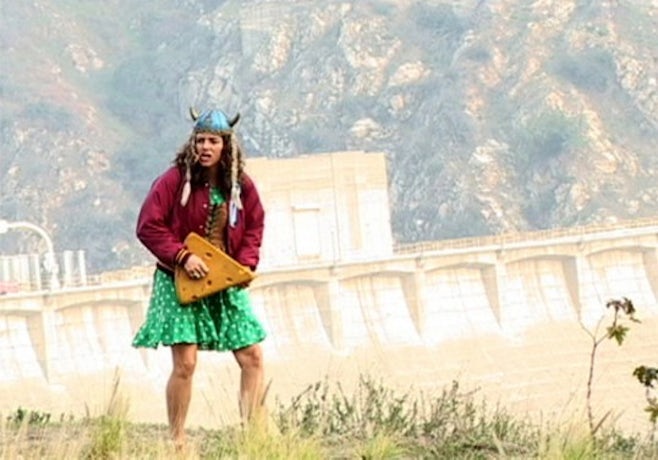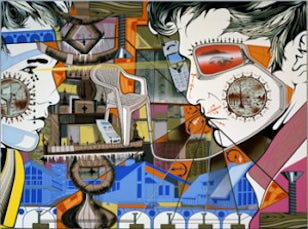
Though Los Angeles is now considered a center for artistic production in the United States second only to New York, the burgeoning contemporary art scene here is by any normal measure still in its infancy. The relative brevity of the city’s artistic history – arguably traceable to the mid-1950s and Walter Hopps’s legendary Ferus Gallery – means that it is comparatively easy to gloss the aesthetic traditions that have predominated among artists living and working in Los Angeles. Leaving aside the work of Los Angeles-based conceptual artists, very generally speaking, material approaches have fallen into two broadly acknowledged categories.
In one camp are the so-called Light and Space artists and ‘finish fetishists’, who used sleek, airy, commercial and industrial materials in their work and were concerned chiefly with the phenomenology of perception; James Turrell, Craig Kauffman, Robert Irwin, Ronald Davis, Peter Alexander, John McCracken, and Larry Bell are among the most notable exponents. On the other end of the spectrum entirely is the LA Pop/Assemblage tradition, typified by artists like Ed Kienholz, Llyn Foulkes, Betye Saar, George Herms, Gordon Wagner, Wallace Berman, and Tony Berlant, whose works incorporated or referenced found objects and cultural detritus and often engaged topical social issues. While Gary Garrels’s exhibition ‘Eden’s Edge: Fifteen LA Artists’ (2006-07) is touted as a self-consciously whimsical survey show predicated on the curator’s sense of what is most current and vital in Los Angeles and not on a tightly constructed argument, taken en masse, the work presented in this show argues vigorously – albeit tacitly – that the ‘finish fetish’ tradition is all but dead in Los Angeles, giving way to work in a variety of media that continues the materially heterogeneous, socially aware, sometimes tawdry, grimy aesthetic and conceptual concerns of the Pop/Assemblage tradition.

Though the exhibition is composed chiefly of younger artists (most born after 1960) who have forged their international reputations in the last ten years, the show begins with a gallery of Ken Price’s globular, technicolor painted ceramic abstractions, which are by turns discomfortingly abject and formally mesmerizing. Born in 1935, at least twenty years older than any other artist in the show, and a peer of now-canonical figures like Robert Irwin and Craig Kauffman, Price’s appearance in the very first gallery of the exhibition is surely calculated to make an historical claim. Unfortunately, however, the rationale subtending this presumably crucial decision is not clearly enumerated in the catalogue or in the exhibition, which leaves the viewer to draw his or her own conclusions. Are we to believe that of all artists working in Los Angeles during the 1960s and 70s, Price has emerged as the most prescient, enduring and relevant?
Price’s work, as it turns out, is not the key that unlocks the infra-logic of Garrels’s show, but rather the inexplicable precursor to fourteen discrete project room shows, tenuously linked – in Garrels’s conception – by a shared interest in assemblage, accumulation, popular culture, cultural detritus, material heterogeneity, and intensive craft. Within this very slack artistic rubric – which Garrels identifies as crucially linked to the ‘complications…ambiguities [and] exuberance of life in this city’ – are some judiciously chosen works that register the immense vitality of art production in Los Angeles. The more injudicious selections, on the other hand, call to mind Richard Serra’s contemptuous classification ‘post-Pop Surrealism’, a term he uses to describe theory dependent art descended from Duchamp and siphoned through Pop and Surrealist pictorial conventions.

Fortunately, only a few of the artists in the exhibition fit snuggly into this latter category. Lari Pittman’s dense, raucously colorful canvases composed of sharply rendered interlocking and overlapping imagery – deck chairs, remote controls, architectural plans, sharks, flowers, cityscapes, human bodies, and domestic interiors – are brimming over with finesse and technical alacrity, but they are sorely lacking in critical bite. In works like Untitled(2000), Pittman is at great pains to emphasize the material heterogeneity of modern life and the unlikely social interdependencies that exist between people and things – even going so far as to include lines that determine those connections – but the effect is excessively didactic and literal. In the end, the painting functions more as a diagram that directs the viewer’s understanding, than as a work of art that opens out meaning. Similarly over-determined are Monica Majoli’s looming watercolor and gouache portraits of men in rubber body suits, typically shown in a state of pronounced sexual arousal and utterly indifferent to the scrutiny of the viewer. The wispy, ethereal gray-tones of these paintings are formally appealing, but ultimately they are little more than publicly available illustrations of private, benignly deviant acts.
While other works by Sharon Ellis and Jim Shaw are all too emblematic of Serra’s aforementioned category, there are, on the whole, many more high points than disappointments. Mark Bradford’s multi-media paintings are at once masterful allovers in the tradition of Pollock and de Kooning, and chaotic mélanges of socially charged urban detritus that recall Robert Rauschenberg’s seminal Combines. In newer works like America, 2006, Bradford has introduced an industrial silver paint to his typically audacious admixture of elements, which makes the canvas bristle with energy.
Like his Los Angeles-based peer, Nathan Mabry, Matthew Monahan’s sculptures deftly combine Minimalist strategies and conventions of museological display, with ancient figural fragments that evoke both Eastern and Western traditions. The Seller and the Sold, 2006, for instance, shows an upended, wildly contorted Classical hero incased within a pristinely fabricated glass vitrine worthy of Larry Bell. The effect is mysterious and deeply auratic. Similarly strong, though far more humorous, are Liz Craft’s imaginary counter-culture icons rendered in beautifully patinated bronze.
Elliot Hundley’s staggeringly intricate, wall-mounted multi-media works draw deeply on the inheritance of Assemblage as well, but, tellingly, it is Jason Rhoades’s installation that represents the clearest and most radical advancement upon that tradition. In the early part of his career, Kienholz, the charismatic paramour of West Coast Assemblage, displayed an uncanny capacity to bring formal resolution to disparate groupings of materials, and to use the resultant associations to spin cultural narratives, and to make wry, often critical social comments. Kienholz treated topical issues not through traditional representational means, but through material analogy and implication. One of his seminal works, Illegal Operation, 1962, which addresses the issue of illegal abortion in the United States at mid-century, is a signal example. Like Kienholz, Jason Rhoades developed throughout his tragically short career (he died in 2006 shortly after completing his last and most ambitious work, Black Pussy) a sophisticated analytical parity between the sundry materials he crammed into his chaotic, immersive installations and the correspondingly complex social and material conditions of the modern world; particularly those native to the sprawling, de-centered megalopolis that is LA.
Rhoades’s Twelve-Wheel Waggon Wheel Chandelier, 2004, was installed in the Hammer’s stunning but awkward Vault Gallery, originally built to house the museum’s Leonardo codex. The finale of Eden’s Edge, Rhoades’s work is as beautiful as it is prurient, as elegant as it is ridiculous, and as whimsical as it is pointedly provocative. Using a motley array of materials ranging from playfully phallic vegetables, to wooden wagon wheels that evoke the conquest of the West, to luminous neon words that are all slang terms for female genitalia, the installation is an exercise in the ability of art to incorporate and exceed the mundane, to present a worldview that is outlandish and preposterous, but somehow intuitively accurate. Much the same could be said of Mark Bradford, Matthew Monahan and Elliot Hundley, so perhaps it is this tradition – one of audacious material invention and caustic critical comment – that characterizes the best art being produced in LA, and perhaps a more focused examination of this emergent tradition might have brought some much-needed cohesion to a lively but confused show.
– Christopher Bedford
